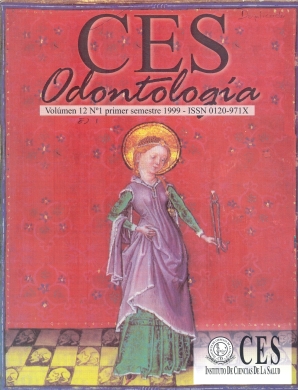EFICACIA DE LA TÉCNICA DE MODELADO CON VIDEO PREOPERATORIO EN PACIENTES DE 4 A 6 AÑOS DE EDAD
Resumo
Este estudio se realizó para evaluar el comportamiento de niños de difícil manejo utilizando la técnica de modelado con video. La muestra consistió de 15 niños con experiencia odontológica previa, cuyo comportamiento fue clasificado como definitiva o levemente negativo de acuerdo con la escala de Frankl. Cada niño se atendió en dos citas; en la primera se sometió a un tratamiento restaurador convencional y previo a la segunda cita, los pacientes observaron un video donde se mostró la atención de un niño de buen comportamiento. Inmediatamente después. recibió tratamiento similar al de la primera cita. Todos los procedimientos fueron grabados y editados para ser evaluados por un juez, previamente estandarizado, quien clasificó el comportamiento de los niños en cada momento operatorio y en forma global para cada cita. Al comparar el comportamiento entre las dos citas, se encontró que hubo una mejoría del 53.3% (p= 0.25) durante la aplicación de la anestesia. 73.3% (p = 0.02) durante el tallado de la cavidad y 600..6 (p = 0.001) al momento de la restauración. En la evaluación global, la técnica demostró ser efectiva en el 800..6 de los pacientes (p = 0.008). Se concluyó que la técnica puede ser efectiva cuando es utilizada en niños de 4 a 6 años con comportamientos levemente negativos, logrando éxito en el mejoramiento del comportamiento disruptivo. ABSTRACT The purpose of this study was to evaluate the efficacy of Modeling with a preoperative video as a behavior management technique. Fifteen patients between 4 and 6 years of age which required restorative dental treatment with the use of local anesthetic and which had previous dental experience were selected. Patients were preclassified according to their presumptive behavior into definetly or slightly negative behavior categories based on the Frankl Scale. Patients were afterwards submitted to restorative treatment in two appointments; during the first visit, conventional treatment was performed while during the second one, patients were shown a 5 minute preoperative video where the cooperative behavior of a child of a similar age was shown prior to recieving conventional restorative treatment. Both appointments were filmed and edited and afterwards assesed by a previosuly standarized judge who determined behavior for three different operative moments as well as overall behavior using the Frankl Scale. Results indicated that comparisons between both appointments revealed that there was a 53.3% improvement during the application of local anesthesia (p=O.25), 73.3% (p=O.02) during cavity preparation and 60010 (p=O.OO1) during the placement of the restoration. The technique also demonstrated to be effective in improving overall behavior (p=O.OOB). It was concluded that the technique is effective in children between 4 and 6 years old with slightly negative behavior.Downloads
Não há dados estatísticos.
Downloads
Publicado
2009-11-07
Como Citar
1.
CADAVID PA, GIAIMO CA, CÁRDENAS JM. EFICACIA DE LA TÉCNICA DE MODELADO CON VIDEO PREOPERATORIO EN PACIENTES DE 4 A 6 AÑOS DE EDAD. CES odontol. [Internet]. 7º de novembro de 2009 [citado 22º de julho de 2024];12(1):36-40. Disponível em: https://revistas.ces.edu.co/index.php/odontologia/article/view/788
Edição
Seção
Artículo de Investigación Científica y Tecnológica
| Métricas do artigo | |
|---|---|
| Vistas abstratas | |
| Visualizações da cozinha | |
| Visualizações de PDF | |
| Visualizações em HTML | |
| Outras visualizações | |



